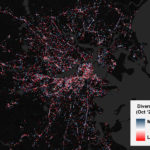 A recent study conducted by researchers at MIT has revealed that the COVID-19 pandemic has had a significant impact on the frequency of interactions between residents of urban areas and individuals from different income brackets.
A recent study conducted by researchers at MIT has revealed that the COVID-19 pandemic has had a significant impact on the frequency of interactions between residents of urban areas and individuals from different income brackets.
By analyzing the movement of people in four cities across the United States, the study discovered a decline of between 15% and 30% in the number of visits made by residents to areas with different socioeconomic characteristics than their own. Consequently, this decrease in mobility has resulted in a reduction of opportunities for people to engage with individuals from diverse social and economic backgrounds.
“Income diversity of urban encounters decreased during the pandemic, and not just in the lockdown stages,” the researchers explain. “It decreased in the long term as well, after mobility patterns recovered.”
Urban movement
Undoubtedly, the study reveals a significant and immediate decline in urban mobility during the spring of 2020, coinciding with the implementation of policies aimed at temporarily closing various institutions and businesses in response to the emergence of the deadly COVID-19 virus.
Although these restrictions were eventually lifted, and overall urban movement began to recover, the study highlights a notable transformation in movement patterns within cities. Individuals now exhibit a narrower range of destinations they visit, indicating a reduction in the diversity of places frequented.
“We see that changes like working from home, less exploration, more online shopping, all these behaviors add up,” the authors continue. “Working from home is amazing and shopping online is great, but we are not seeing each other at the rates we were before.”
Tracking movement
In order to conduct this study, the researchers meticulously analyzed anonymized cellphone data from a sample of 1 million users spanning a three-year period commencing in early 2019. Focusing specifically on four prominent American cities—Boston, Dallas, Los Angeles, and Seattle—the study examined visits to approximately 433,000 distinct “point of interest” locations within these urban centers. To ensure accuracy, the researchers cross-referenced these visits with data from Infogroup’s U.S. Business Database, which provides comprehensive annual records of company information.
To assess the socioeconomic status of the study participants, the researchers employed data from the U.S. Census Bureau. Using the average income of the census block—an encompassed smaller geographical area—where individuals resided, the researchers classified them into one of four income quartiles. This income-level categorization was applied to every census block within the four cities, allowing for an evaluation of instances where individuals spent between 10 minutes and four hours in a census block different from their own. This provided insights into the frequency of visits to areas across different income quartiles.
The research findings indicate that by late 2021, overall urban mobility levels were gradually approaching pre-pandemic norms. However, there was a noticeable decline in the diversity of locations residents visited. Notably, people made considerably fewer visits to cultural institutions like museums, leisure venues, transportation hubs, and coffee shops.
Interestingly, visits to grocery stores remained relatively consistent, yet individuals tended to remain within their own socioeconomic circles even for routine grocery shopping, displaying a lack of movement beyond their established spheres.
“Early in the pandemic, people reduced their mobility radius significantly,” the authors explain. “By late 2021, that decrease flattened out, and the average dwell time people spent at places other than work and home recovered to pre-pandemic levels. What’s different is that exploration substantially decreased, around 5% to 10%. We also see less visitation to fun places.”
Variable settings
By incorporating four cities that implemented diverse policies regarding the reopening of public sites and businesses during the pandemic, the study enabled the researchers to assess the influence of public health measures on urban mobility.
Remarkably, despite the variations in these settings, a consistent trend emerged—there was a notable reduction in the range of mobility observed by late 2021. This implies that irrespective of the specific policy approaches adopted, a narrowing of movement patterns within cities became evident over time.
“Despite the substantial differences in how cities dealt with COVID-19, the decrease in diversity and the behavioral changes were surprisingly similar across the four cities,” the authors explain.
Social impact
The researchers underscore the potential long-term societal implications stemming from these shifts in urban mobility. Previous studies have demonstrated a strong correlation between diverse social connections and enhanced economic prosperity for individuals in lower-income brackets.
While certain interactions between individuals across different income quartiles may be fleeting and transactional in nature, the collective evidence indicates that these restrictions in movement have resulted in a broader reduction of more substantial connections.
Consequently, the narrowing of experiences can undermine civic bonds and diminish valuable political networks, further exacerbating the potential consequences of this phenomenon. It is essential to recognize the wide-ranging impact of these changes on various aspects of society, highlighting the need for proactive measures to address and mitigate the implications of restricted urban movement.
“It’s creating an urban fabric that is actually more brittle, in the sense that we are less exposed to other people,” the researchers conclude. “We don’t get to know other people in the city, and that is very important for policies and public opinion. We need to convince people that new policies and laws would be fair. And the only way to do that is to know other people’s needs. If we don’t see them around the city, that will be impossible.”